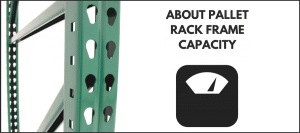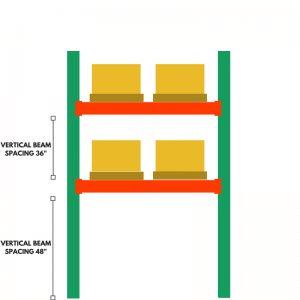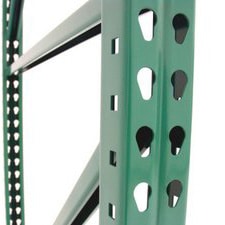Pallet Rack Upright Capacity
We’ve covered pallet rack beam capacity and how to make sure you’re getting strong enough beams for your application. Pallet rack frame capacity works a little differently. How so?
Unlike beam capacity, upright frame capacity can change. This is because the weight-bearing length of an upright frame column can change depending on the number and spacing of beam levels. Sound confusing? Let’s take a closer look and discuss rack load calculation.

How Pallet Rack Frame Capacity Works
When we talk about pallet rack frame capacities, we mean the capacity per unsupported length of the upright frame column. In other words, the distance between two beam levels or between a beam level and the floor. This is more commonly known as the “vertical beam spacing.”
One great thing about selective pallet racking is that beam levels are adjustable. This lets you, the end user, customize your racking to your own unique needs. You can even re-slot your beams as inventory shifts and demands change.
Imagine a section of racking with one beam level at 48” from ground level and a second beam level at 84” from ground level. The vertical beam spacing between beam levels is 36” and the vertical beam spacing between the ground and first beam level is 48”.

What makes frame capacities tricky is that the 48” of unsupported column can bear less weight than the 36” span. This is because weight can exert more torque over longer distances.
Because vertical beam spacing changes from one application to another, each manufacturer must set a standard vertical beam spacing at which all of their frames will be rated. For many manufacturers, this length is 48” (Steel King, who uses 36”, is a notable example).
For example, a 24” x 96” Ridg-U-Rak frame is rated at 16,700#, assuming 48” beam level spacing. If the user were to change the vertical distance between beam levels, the capacity would change along with it. If they added beam levels, for example, it would increase. If they subtracted beam levels, it would decrease.
Rack Load Calculation
Calculating your required pallet rack load capacity or upright frame capacity can be done with a simple rack load calculation.
First, take the estimated maximum load per beam level, and multiply that by the number of beam levels there will be in a section of racking. You’ll then want to factor in your vertical beam level spacing, or the unsupported length of frame we talked about earlier.
Example: You’ve calculated your beam levels maximum load capacity and reached a total of 17,000# for the system. Your largest vertical beam spacing will be 48″. In this scenario, you’ll need frames that are rated at 17,000# or higher at 48” beam spacing.
Manufacturers provide capacity charts that show the capacity at a given vertical beam spacing. Here’s an example of Ridg-U-Rak’s teardrop frame capacity chart.

Other Upright Frame Safety Considerations
Capacity considerations aren’t the only important pieces of information to keep in mind when it comes to upright frames. Here are a few other things we recommend taking into consideration to keep your warehouse safe and protect your investment.
Pallet Rack Height-to-depth Ratio
The height-to-depth ratio is pretty simple: the Rack Manufacturers Institute advises that pallet rack frames be no more than six times taller than they are deep. This 6:1 ratio is used as the rule of thumb because it allows for greater stability in case of collisions, seismic activity, and other forces.
In the case of a frame that exceeds the 6:1 ratio, row spacers can be used to “tie” one row of racking to another, increasing the overall depth and bringing the combined rows within the 6:1 ratio.
Pallet Rack Anchors
Pallet rack anchors are concrete anchors that secure the pallet rack frame to the flooring. The standard industry recommendation is to anchor all pallet rack frames at all times. They may sound like just another accessory but in reality, pallet rack anchors are a vital part of virtually every selective pallet rack system.
Column Protectors and Frame Protection
One of the most common types of accidents to occur in warehouses is forklift collisions with upright frame columns. Even at slow speeds, forklift tines can dent upright columns. A damaged frame column is often a weakened one. To help protect against this, we recommend the use of column protectors with pallet rack frames.
Column protectors are either bolted to the ground or secured to the frame itself and defend against forklift collisions. At Pallet Rack Now, we stock a variety of column protector products, including the RamGuard and our standard 12″ column protector.
If you need help calculating your rack load capacity or choosing upright frames for your storage system call 888-578-1578 or get a quote today!

